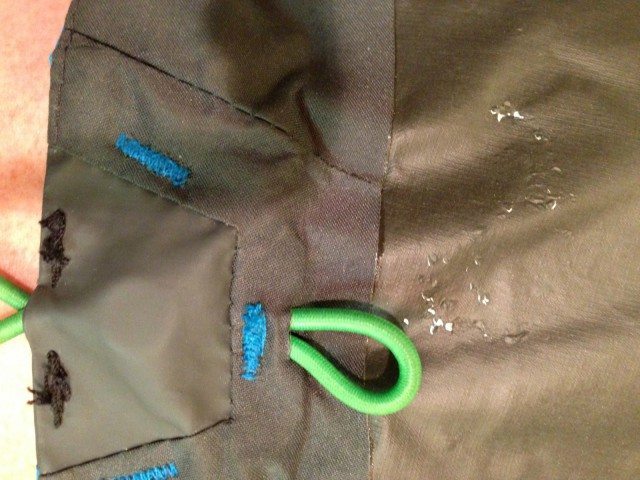Packability
This jacket packs down small. I mean really small, as in beer-can-size-small if you push it. No matter what the weather, I always threw this jacket into my bag. A 10.8 oz. insurance policy is a pretty good deal, I figure.
The lining is smooth, which makes the jacket easy to throw on quickly over any layer, and the hood opening is well designed to keep water from dripping on your face or down your front.
Breathability
It also breathes very well, better than any other hard shell I’ve worn.
(Disclaimer: I have not yet tested a coat with either Mountain Hardware’s new DryQ fabric nor Polartec’s Neoshield, though I’ve heard glowing reviews about both.)
On a hike in the pouring rain in the humid Northeast, the jacket still moved moisture out and didn’t get clammy.
DWR Treatment
When I first got the Super Cell, the jacket beaded water flawlessly. But after about 30 days of normal use, water no longer beaded on the jacket.
Instead, it soaks the outer layer of the shell’s arms (more on that later under “Waterproofing”). Although companies like Nixwax make products to revitalize DWR treatments, I’d expected the DWR to last longer than a month.
And take note—it’s important to wash the jacket before applying aftermarket DWR treatments since washing can revitalize the DWR. A warm iron can also help bring back waterproofing capabilities, but make sure it’s not too hot.
The outer shell of the Super Cell feels like a typical hard shell, with a little stiffness and crinkle. The inside layer is the Gore-Tex membrane, which feels smooth and cool on exposed skin.

Be careful, however, with the inner lining. I’ve found that it has a tendency to get micro tears during normal use, which can result in pieces flaking off. (By normal use, I mean pulling the jacket on quickly over layers, occasionally scraping and snagging the exterior on rocks and trees, and cramming the jacket back into a pack.)
The lining is designed to protect the laminate, so damage to the lining could affect the jacket’s waterproofing abilities. Again, more on this below.
Waterproofing
But breathability and waterproofing don’t always go hand-in-hand. In the case of this particular Super Cell, it seems like waterproofing was sacrificed for breathability.
In the Northeast hike through the pouring rain, the moisture the jacket allowed to pass through the membrane was rain, not sweat. The arms of the jacket seeped water through its face, not the seams, making me think I got a faulty jacket.
While not enough to qualify as a ‘soaking,’ a hard shell should not seep water, especially a hard shell only six months off the shelf. Although on the outside the fabric looks intact and doesn’t have any significant scratches or abrasions, the waterproofing failed.
Over the six months I’ve worn this jacket, it only beaded water during the first month of use and has since leaked in the sleeves every time I’ve worn it in heavy rain. I could have washed the jacket with a DWR revitalizer, but I find it hard to believe a properly constructed hardshell would fail in less than six months. I have owned cheaper coats that lasted several years before needing DWR-treatment renewal.
Based on this experience, I returned the jacket to Patagonia. They agreed the jacket had failed, and gave me a full refund.
Although the lining had small flakes coming off in the body, the lining of the sleeves was in perfect condition, leading me to conclude the issue was with the Gore-Tex membrane, not the Patagonia construction.
I have a pair of Marmot Minimalist pants constructed with the same Gore-Tex Paclite membrane that have performed held up very well under heavy use for more than a year. I clearly got a faulty product. I have several friends with Paclite jackets such as the Marmot Minimalist Jacket (as opposed to the Minimalist pants which I wear regularly), and none of them have had a similar experience with the membrane failing. Given that there was no damage to the inner liner in the arms, I think this was an issue with Gore-Tex’s membrane, not an issue with Patagonia’s construction.
If you have had a different experience with either the Super Cell jacket or Gore-Tex Paclite, please leave a comment, as I would love to compare stories. Ultimately Patagonia stands behind their products and is always willing to work with customers who’ve had a product fail in the field.
Bottom Line
The Super Cell is well designed and fits very well. The features are smart and minimalist, but utilitarian and versatile. In my pack, the Super Cell weighs next to nothing and takes up very little space.
I think Patagonia is on the right track with the Super Cell. It’s a jacket designed for backcountry use, be it backpacking, climbing, or skiing.
Because of its light weight and packability, it’s awesome for climbing, but also has enough features to perform well while backpacking, and is durable enough for skiing—so long as you’re not crashing into things.
Even though the jacket I received was faulty , I would still recommend the Super Cell. The fit and features fall in line with what I believe makes a quality, lightweight, affordable, hard shell. Plus it’s good to know that if there is an issue with the jacket, Patagonia will stand behind their product.
